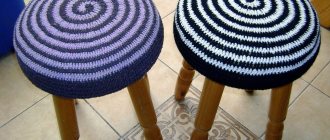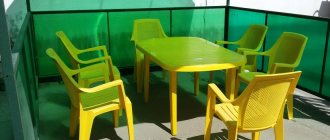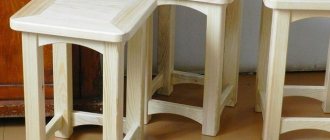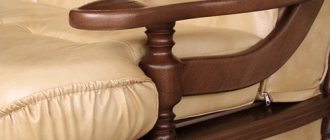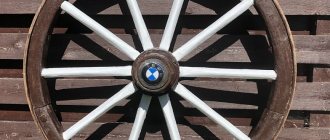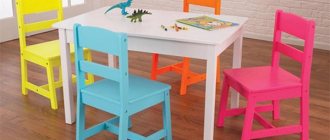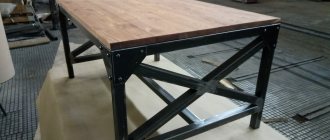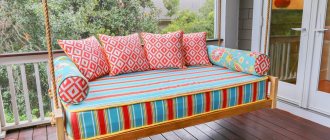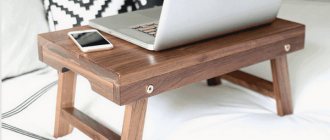I had stools from Ikea in my kitchen, beautiful ones with holes, but because of these slits in the seat they were terribly uncomfortable. I don’t know what the Swedish designer was thinking, but I had to think about how to sew covers for stools with an elastic band with my own hands
It took me exactly two hours to work while my youngest enjoyed his afternoon nap. Even a novice seamstress who has a sewing machine at home can repeat my master class today.
Options for knitted capes
Most covers, covers and rugs for home furniture can be divided into two categories:
- Mat-cover for a stool. According to the design option, such a cape can be round or square. Distinction is usually achieved through the use of patterns, color combinations, types of edges and embellishments. It should be borne in mind that round covers are less labor-intensive to manufacture, while the square shape gives more space for imagination.
What function they should perform determines what shape, threads and style to choose in the final result. - Chair cover. There are two types of such covers: element-by-element and made as one whole. In the first case, the seat and back covers are made as separate parts. In the second, the case is a solid product. Therefore, it requires quite a lot of time for knitting, fitting and finishing: such products are most often provided with an elastic collar so that the cover does not slip off the chair.
Hand-made products will help add individuality to the environment.
Preparing fabric and foam
Before sewing the cape, you will need to carefully smooth the fabric so that there are no wrinkles on it. You will also need to prepare foam rubber for softness. There are several types of fillers that are used for sewing furniture covers. The most popular of them are:
- padding polyester Artificial and durable foam rubber that does not lose its shape, has good elasticity, and shows high thermal insulation properties. Sintepon is inexpensive, which is why many users choose it for upholstering stools. The downside is that the material allows air to pass through and loses its properties at low temperatures;
Sintepon for capes
- holofiber. The material is made of springy fibers, it shows good ductility. Hollow fiber can be washed in a washing machine. The fiber is breathable, easy to clean, does not require special care, and holds its shape for a long time. Disadvantages - the material can absorb liquid, it does not tolerate increased humidity levels in the room;
- foam rubber Dense material that holds its shape well. Foam rubber is flexible, practical, hypoallergenic. It withstands temperature changes in the room and retains its shape at sub-zero temperatures. Disadvantages - the fiber is not environmentally safe, and foam rubber is also quite fire hazardous.
For your information! Before you start sewing, you also need to take measurements of the furniture in order to cut the fabric to the right size.
Filler for accessories
How to crochet a cover for a stool
Knitting as a process seems simple and easy only from the outside. In fact, there are a lot of subtleties and nuances here. Therefore, when starting to knit a new product, you need to pay attention to the following points:
- Knitting technique. This is the determining factor. Ultimately, the appearance of the future cover depends on it.
- Yarn. It is not necessary to buy a separate skein for each option. In some cases, it is possible to make beautiful things knitted exclusively from leftovers.
To create one cape, it is not necessary to buy new skeins of thread.
Use remains in a variety of ways. Little tricks:
- If you fail to guess the size and the rug turns out to be smaller, you can increase the size using a border.
- It is better to make bedding from wool.
- To avoid “walking” in height, it is advisable to choose threads of the same type and, if possible, from the same manufacturer.
If your goal is to create a product “for the soul,” one that will attract the eye and complement the interior, then you need to first of all include the designer’s thinking.
Note! Knitting using a crochet hook takes significantly more time than the same amount of work done using knitting needles. Therefore, it is recommended to carefully select the scheme you like.
The harmony of the color scheme with surrounding objects and walls can be seen, as well as such nuances as ornaments and patterns that can become the highlight of any style.
Typical patterns of knitted rugs
To crochet a stool cover the way it appears in your imagination, you need to be able to read patterns well and strictly adhere to them. To begin with, you should choose models that are simpler, either based on practical considerations or specific operating conditions.
To preserve the finished product for as long as possible, it should be based on a dense base.
Square, under a stool
The square cover is one of the most popular, since most stools and chairs have this exact seat shape.
Typical knitting pattern:
A very interesting and simple option is the scheme for creating a square seat from colored stripes.
The process usually starts with measuring the seat. If you have no ideas for decoration, a cover with alternating colors and stripes would be a good solution. This will not affect the process itself, but it will look interesting. You can choose colors in a certain order or make a “chessboard”; the choice here is purely individual.
The required strip length is easy to calculate. It should be the same as the length of the seat. The width of the stripes themselves should be the same.
The most difficult thing with this pattern is tying the corner. Having reached the edge, you should add a little more knots: two elements starting in the same arch. As for the assembly, it is best to do it using a contrasting thread: the connecting column must be formed on symmetrical loops at the edges of the squares.
Thus, you will receive a fashionable piece of furniture in a hand-made style.
Important! To avoid the appearance of “waves”, you should choose a hook for the connection that is a size smaller than the main one.
Round, for seat with sides
Since it is much easier to crochet a round stool cover than a square one, denser threads are usually used for such products.
Example diagram:
The simplest option is a round knitted chair cover.
The main thing is to always start the circle from the center! In its simplest form, knitting is carried out according to the rule of addition.
In general, to create a foundation, the work order might look like this:
- Fit the air loops and roll them into a ring.
- Wrap around the ring. The first row comes with single crochet stitches.
- Use the resulting base in accordance with the chosen scheme.
For a crocheted stool cover, it is best to use thick acrylic yarn and a large hook.
The required diameter is determined by the number of rows completed. The edge (last) row can be passed through connecting posts with an elastic thread to form a collar.
Rug-flower
Recently, crocheting patterns for stool covers in the stylization of a flower have become popular: chamomile or sunflower.
Example diagram:
The thing will be voluminous, softer, and sitting on such a stool will be a pleasure.
To knit the same sunflower, you will need yarn of two colors: brown and yellow. In general, such work includes three main stages: creating the middle, knitting the petals and connecting the resulting parts. It is best to use cotton threads for such a cover.
Sequencing:
- Tie the base in any convenient way
- Start the petals with air loops, tying a single crochet on both sides.
- You can attach the petals with a simple thread.
DIY knitted cover for a stool in the shape of a bright sunflower.
Chair back cover
Typically, such covers are equipped with additional decorations and are knitted using patterns and several colors.
Example diagram:
To create a rectangular cape, you can use the same pattern as for a square one.
Since such a product is not a crocheted cover for a stool, it requires great skills and abilities. Therefore, as an algorithm of action, it is worth citing several general techniques:
- The base is a solid canvas. Can be made in both color and pattern. In order not to miscalculate the dimensions, you will need to measure the height and width of the backrest. You need to knit it in a single piece of double height, then fold it in half and sew it together.
- You can tie lace along the edge.
Rectangular covers for the backs of chairs, made by yourself.
Full chair cover, with backrest
Such covers use the principle of a continuous passage, so the type, type and style are selected individually. In principle, they always look good, and they are quite easy to knit:
- Measure the dimensions of the seat and backrest.
- Start with air loops - they are typed to the required width.
- As for the technique, you need to knit with simple double crochets: just like crocheting a cover for a stool, only in parts: along the length of the seat, back and bend. All elements are connected to each other by air loops.
- The sides and back are hemmed in the same way.
For decoration, simple ornaments are chosen, like this:
Choose the color at your discretion, based on the color scheme of the interior.
Materials
Requirements for materials stem from the place and nature of operation of the future product. If this is a decorative cape, it is preferable to use a simpler type of thread, while a chair cover will require stronger yarn. From here we can formulate general recommendations in relation to the preparation of materials:
- The choice of threads with different colors should take into account the length of the skein. Ideally it should be the same.
- It is advisable to select skeins of the same length (on average, 150 m per 100 g).
- For beginners, it is better to stick to cotton yarn (“Iris” or similar).
- It is allowed to take “prickly” threads.
If the pattern for knitting pillows on a stool involves the use of threads of different colors, their type and brand should still be the same.
Important! The hook should be selected based on the thickness of the yarn - the narrowest point should be twice as thin as the selected thread. Otherwise, the structure may turn out to be “loose” and sloppy. For most cases, the optimal diameter will be 3mm.
Crochet cover for a stool
Many people have a desire to knit, but only a few actually get into knitting. Most people are put off by the need to memorize dozens of types of loops, and especially to understand the complex patterns that are often given in magazines. In fact, there is nothing super complicated here. It's not that hard, just remember a few rules:
- Rectangular and square diagrams are “read” from bottom to top. Round - from the center.
- When knitting covers on a round stool, you need to put it on from the center. You should remember about the lifting loops so that the radius is the same. The number of added columns must be equal to the number of existing ones.
- For an even row, counting goes from left to right. For odd numbers it’s the other way around.
If you follow the description of the patterns, the time spent knitting will not be onerous work.
In addition, you can print out and put a sheet of symbols next to it - this will make it easier to read the diagrams.
Note! Covers and rugs, knitted according to simple patterns, are made using basic types of loops (connecting, columns, double crochets, double crochets).
Create a stunning flower that will soon bloom on your stool with intricate ethnic or abstract patterns.
How to decorate: types of decor
Knitting is a process that is impossible without the work of imagination and imagination. Since crocheting patterns for a stool cover mostly involve simple shapes, why not decorate them:
- Lace and tassels. This element looks good around the edges. Especially on a square shape.
- Embroidery. Both classic beads or rhinestones and top processing with threads are used.
- Bows. They look good made from ribbons or fabric, and also knitted.
- Pompoms. Like tassels, they will perfectly decorate a cape, except that this is more suitable for children’s furniture.
To create it, you need to knit a sufficient number of individual colors and then connect them, guided by the diagram.
You can also use various patterns or unusual combinations of all kinds of circles, squares, lines and zigzags as decorations. For more experienced ones, it makes sense to “play around” with the form.
Required materials and tools
To sew a cape, you will need to prepare the following tools:
- soap or chalk for marking;
- ruler or centimeter;
- awl (when using leather);
- pencil;
- pins.
The seams of the product are sewn on a sewing machine. The pattern can be made on a cardboard or plastic sheet. Its dimensions must exceed the dimensions of the future cover. In the process you will also need an elastic band (at least 3 cm wide) and threads (according to the color of the future product).
Sewing tools
Work examples
Below are several examples that clearly show how interesting and attractive a hand-knitted cover or rug can be.
Thus, if you have free time, a skein of yarn and imagination, you can do a good job updating old, battered furniture. But even if it’s not old, an original crocheted stool cover will be able to add zest to the interior decor and bring a touch of harmony to the home microcosm.
Criterias of choice
When choosing a cover, you need to first measure the seat of the stool, taking into account its shape. But it is equally important that it fits harmoniously into the interior and emphasizes the design chosen for the kitchen:
- Provence. They use exclusively natural thin fabrics of light, pastel shades (lavender, soft blue, pale yellow, pistachio), but individual bright inclusions are not prohibited. Floral, plant motifs (fabric with small printed patterns), any handmade work (crocheted, embroidered covers) are welcome. You can decorate them with ruffles, bright ribbons, and lace.
- Country. Deliberate simplicity is emphasized by products made of cotton or linen in a cream, grayish or beige shade, imitating undyed fabric. Darker inclusions are acceptable - bottle green, chocolate, dark gray, black, burgundy. Thick, bright woolen covers in a checkered pattern or hand-knitted ones with large, textured patterns will fit just as well into this style.
- High-tech, minimalism. Strict, laconic cut, clear and “geometric” covers for stools are required. Any decor (with the exception of narrow braid along the seams) is a categorical taboo. Suitable colors are white, black, gray, the whole beige range. But the seats can also be bright if this shade is already repeated in the interior. Covers made of fabric with a metallic sheen, leatherette, and jeans will fit well into modern trends.
- Classic. The epitome of understated elegance. Accessories should be distinguished by their simplicity of cut and almost complete absence of decoration (clear folds are appropriate, but not lush ruffles). They are made from high-quality expensive fabric (for example, satin, satin, silk) or genuine leather, plush in subdued tones. Let's say a discreet geometric or floral pattern. The stool itself should also look “noble”.
- Modern. A very bright and bold style that welcomes everything non-standard - non-trivial color combinations, original shapes, catchy decor.
If possible, the cover on the stool is chosen so that it harmonizes with other textiles in the kitchen - curtains, tablecloths, towels. This room, as a rule, is small in area; pastel colors in the decor will help to “expand” it visually.
A stool cover is not only a decorative, but also a functional item. It also allows you to “refresh” the kitchen interior without major renovations. If you have minimal creative abilities and sewing and knitting skills, you can make a seat yourself - hand-made things are in fashion now. Store-bought items look just as good – there are options to suit any style.
Rules for choosing a kneeling chair, step-by-step DIY production
Provence
Country
High tech
Minimalism
Classic
Modern
